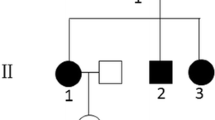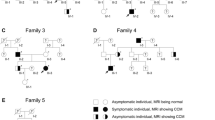Abstract
Family cerebral cavernous malformations (FCCMs) are mainly inherited through the mutation of classical CCM genes, including CCM1/KRIT1, CCM2/MGC4607, and CCM3/PDCD10. FCCMs can cause severe clinical symptoms, including epileptic seizures, intracranial hemorrhage (ICH), or functional neurological deficits (FNDs). In this study, we reported a novel mutation in KRIT1 accompanied by a NOTCH3 mutation in a Chinese family. This family consists of 8 members, 4 of whom had been diagnosed with CCMs using cerebral MRI (T1WI, T2WI, SWI). The proband (II-2) and her daughter (III-4) had intracerebral hemorrhage and refractory epilepsy, respectively. Based on whole-exome sequencing (WES) data and bioinformatics analysis from 4 patients with multiple CCMs and 2 normal first-degree relatives, a novel KRIT1 mutation, NG_012964.1 (NM_194456.1): c.1255-1G > T (splice-3), in intron 13 was considered a pathogenic gene in this family. Furthermore, based on 2 severe and 2 mild CCM patients, we found an SNV missense mutation, NG_009819.1 (NM_000435.2): c.1630C > T (p.R544C), in NOTCH3. Finally, the KRIT1 and NOTCH3 mutations were validated in 8 members using Sanger sequencing. This study revealed a novel KRIT1 mutation, NG_012964.1 (NM_194456.1): c.1255-1G > T (splice-3), in a Chinese CCM family, which had not been reported previously. Moreover, the NOTCH3 mutation NG_009819.1 (NM_000435.2): c.1630C > T (p.R544C) might be a second hit and associated with the progression of CCM lesions and severe clinical symptoms.





Similar content being viewed by others
Data availability
The datasets used and/or analyzed during the current work are available from the corresponding author on reasonable request.
References
Lin J, Liang J, Wen J et al (2021) RNF213mutations of are responsible for sporadic cerebral cavernous malformation and lead to a mulberry-like cluster in zebrafish. J Cereb Blood Flow Metab: Off J Int Soc Cereb Blood Flow Metab 41(6):1251–1263
Wang K, Wu D, Zhang B et al (2018) KRIT1/CCM1Novel and gene variants in chinese families with cerebral cavernous malformations. Front Neurol 9:1128
Horne M, Flemming K, Su I et al (2016) Clinical course of untreated cerebral cavernous malformations: a meta-analysis of individual patient data. Lancet Neurol 15(2):166–173
Flemming K, Lanzino G (2020) Cerebral cavernous malformation: what a practicing clinician should know. Mayo Clin Proc 95(9):2005–2020
Chohan M, Marchiò S, Morrison L et al (2019) Emerging pharmacologic targets in cerebral cavernous malformation and potential strategies to alter the natural history of a difficult disease: a review. JAMA Neurol 76(4):492–500
Yang L, Wu J, Zhang J (2020) A novel CCM2 gene mutation associated with cerebral cavernous malformation. Front Neurol 11:70
Ricci C, Cerase A, Riolo G et al (2021) KRIT1 gene in patients with cerebral cavernous malformations: clinical features and molecular characterization of novel variants. J Mol Neurosci 71:1876
Sahoo T, Johnson E, Thomas J et al (1999) Mutations in the gene encoding KRIT1, a Krev-1/rap1a binding protein, cause cerebral cavernous malformations (CCM1). Hum Mol Genet 8(12):2325–2333
Craig H, Günel M, Cepeda O et al (1998) Multilocus linkage identifies two new loci for a Mendelian form of stroke, cerebral cavernous malformation, at 7p15-13 and 3q25.2-27. Human Mol Gen 7(12):1851–1858
Dubovsky J, Zabramski J, Kurth J et al (1995) A gene responsible for cavernous malformations of the brain maps to chromosome 7q. Hum Mol Genet 4(3):453–458
McDonald D, Shi C, Shenkar R et al (2012) Fasudil decreases lesion burden in a murine model of cerebral cavernous malformation disease. Stroke 43(2):571–574
Wüstehube J, Bartol A, Liebler S et al (2010) Cerebral cavernous malformation protein CCM1 inhibits sprouting angiogenesis by activating DELTA-NOTCH signaling. Proc Natl Acad Sci USA 107(28):12640-12645
Schulz G, Wieland E, Wüstehube-Lausch J et al (2015) Cerebral Cavernous malformation-1 protein controls DLL4-Notch3 signaling between the endothelium and pericytes. Stroke 46(5):1337–1343
Richards S, Aziz N, Bale S et al (2015) Standards and guidelines for the interpretation of sequence variants: a joint consensus recommendation of the American College of Medical Genetics and Genomics and the Association for Molecular Pathology. Gen Med: Off J Am College Med Gen 17(5):405–424
Dinevska M, Gazibegovic N, Morokoff A et al (2020) Inhibition of radiation and temozolomide-induced glioblastoma invadopodia activity using ion channel drugs. Cancers 12(10):2888
Renz M, Otten C, Faurobert E et al (2015) Regulation of β1 integrin-Klf2-mediated angiogenesis by CCM proteins. Dev Cell 32(2):181–190
Goitre L, De Luca E, Braggion S et al (2014) KRIT1 loss of function causes a ROS-dependent upregulation of c-Jun. Free Radical Biol Med 68:134–147
Zhou Z, Tang A, Wong W et al (2016) Cerebral cavernous malformations arise from endothelial gain of MEKK3-KLF2/4 signalling. Nature 532(7597):122–126
Glading A, Han J, Stockton R et al (2007) KRIT-1/CCM1 is a Rap1 effector that regulates endothelial cell cell junctions. J Cell Biol 179(2):247–254
Clatterbuck R, Eberhart C, Crain B et al (2001) Ultrastructural and immunocytochemical evidence that an incompetent blood-brain barrier is related to the pathophysiology of cavernous malformations. J Neurol Neurosurg Psychiatry 71(2):188–192
Tanriover G, Sozen B, Seker A et al (2013) Ultrastructural analysis of vascular features in cerebral cavernous malformations. Clin Neurol Neurosurg 115(4):438–444
Wong J, Awad I, Kim J (2000) Ultrastructural pathological features of cerebrovascular malformations: a preliminary report. Neurosurg 46(6):1454–1459
Retta S, Glading A (2016) Oxidative stress and inflammation in cerebral cavernous malformation disease pathogenesis: two sides of the same coin. Int J Biochem Cell Biol 81:254–270
Goitre L, Balzac F, Degani S et al (2010) KRIT1 regulates the homeostasis of intracellular reactive oxygen species. PLoS ONE 5(7):e11786
Perrelli A, Retta SF (2021) Polymorphisms in genes related to oxidative stress and inflammation: Emerging links with the pathogenesis and severity of Cerebral Cavernous Malformation disease. Free Radic Biol Med 172:403–417
He R, Li H, Sun Y et al (2020) Homozygous NOTCH3 p.R587C mutation in Chinese patients with CADASIL: a case report. BMC Neurol 20(1):72
Pedapati R, Vishnu V, Singh M et al (2020) CADASIL and cavernomas: a common mechanism. Ann Indian Acad Neurol 23(4):570–572
Benedetti V, Canzoneri R, Perrelli A et al (2022) Next-generation sequencing advances the genetic diagnosis of cerebral cavernous malformation (CCM). Antioxidants (Basel, Switzerland) 11(7):1294
Funding
This study was supported by a Fujian Clinical Research Center for Neurological Diseases (principal investigator: Professor Dezhi Kang), a grant from Fujian Provincial Department of Science and Technology (Grant number: 2020Y2003), and also supported by National Natural Science Fund (No. 81870930 and No. 82171327, principal investigator: Dezhi Kang) grant from the National Natural Science Foundation of China.
Author information
Authors and Affiliations
Contributions
Conceptualization: D.Z.K., Y.X.L., and F.X.L.; subjects collection: H.J.W., L.Y.Z., and Q.H.; Brain MRI scan and diagnosis: W.L.H. and Y.Q.K.; analysis of data and bioinformatics: C.W.L. and P.H.L.; writing—original draft and figure preparation: C.W.L. and P.H.L.; review and editing: F.X.L.; supervision: D.Z.K., Y.X.L., and F.X.L.
Corresponding authors
Ethics declarations
Competing interests
The authors declare no competing interests.
Additional information
Publisher's note
Springer Nature remains neutral with regard to jurisdictional claims in published maps and institutional affiliations.
Rights and permissions
Springer Nature or its licensor (e.g. a society or other partner) holds exclusive rights to this article under a publishing agreement with the author(s) or other rightsholder(s); author self-archiving of the accepted manuscript version of this article is solely governed by the terms of such publishing agreement and applicable law.
About this article
Cite this article
Li, C., Liu, P., Huang, W. et al. A novel KRIT1/CCM1 mutation accompanied by a NOTCH3 mutation in a Chinese family with multiple cerebral cavernous malformations. Neurogenetics 24, 137–146 (2023). https://doi.org/10.1007/s10048-023-00714-y
Received:
Accepted:
Published:
Issue Date:
DOI: https://doi.org/10.1007/s10048-023-00714-y




